 The website is in construction. New files will be uploaded as soon as they are available.
The website is in construction. New files will be uploaded as soon as they are available.

World Federation of National Mathematics Competitions
The history of WFNMC
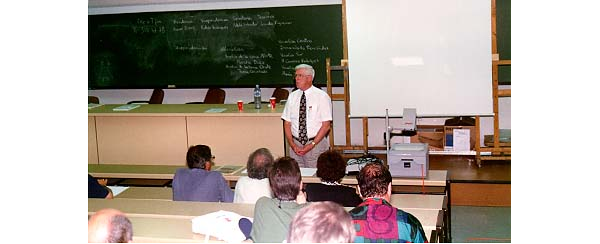
- The World of Mathematics Competitions
- WFNMC in dates
- Goals of WFNMC
- The Essence and the Role of WFNMC
- Structure and Activities of WFNMC
- People involved with WFNMC
- WFNMC in Pictures
| Petar Kenderov President of WFNMC Academy of Sciences Sofia, BULGARIA vorednek@yahoo.com |
The World of Mathematics Competitions
A mathematics competition for primary school students was held in Bucharest, Romania, as early as 18851 . There were 70 participants and eleven prizes, awarded to 2 girls and 9 boys. One cannot completely rule out the possibility that similar competitions were held elsewhere even before 1885. Nevertheless, the Eötvös competition in Hungary (held in 1894) is widely credited as the forerunner of contemporary mathematics (and physics) competitions for secondary school students. The competitors were given four hours to solve three problems (no interaction with other students or teachers was allowed). The problems in the Eötvös competition were designed to check creativity and mathematical thinking, not just acquired technical skills. In particular, the students were often asked to provide a proof of a statement. The Eötvös competition model is now widely spread and still dominates a large portion of competition scene.
The year 1894 is notable also for the birth of the famous math journal KöMal (an acronym of the Hungarian name of the journal), which translates to "High School Mathematics and Physics Journal". It was founded by Dániel Arany, a high school teacher in Györ, Hungary. The journal was essential in the preparation of students and teachers for competitions. Readers were asked to send solutions to problems published in the journal. As noted by G.Berzsenyi2 , about 120 — 150 problems were published in KöMal each year. The response was impressive: about 2500 — 3000 solutions were received yearly. The best solutions and the names of their authors were published in following issues of the journal. This type of year-round competition helped many young people discover and develop their mathematical abilities. Many of them later became world-famous scientists (for more information in this direction, see the Web-pages of KöMal ).
About the same time, similar development occurred in Romania. The first issue of the monthly Gazeta Matematică was published in September 1895. The journal organized a competition for school students, which improved in format over the years and eventually gave birth to the very effective contemporary national system of competitions in Romania. Soon other countries started to organize mathematics competitions. In 1934, a Mathematical Olympiad (with this name) was organized in Leningrad, USSR (now St. Petersburg).
To compete means to compare your abilities with the abilities of others. The broader the base of comparison is, the better. This seems to be the motivation for the natural transition from school competitions to town competitions, to national and, finally, to international competitions. In 1959 the flagship of mathematics competitions, the International Mathematics Olympiad (IMO), was born. It took place in Romania with participants from seven countries: Bulgaria, Czechoslovakia, German Democratic Republic, Hungary, Poland, Romania, and the Soviet Union (USSR). The second IMO (1960) was organized by Romania as well, but since then it has been hosted by a different country every year (except 1980, when no IMO was held). Over the years, the participation grew dramatically: the 2005 IMO in Mexico in gathered 513 competitors from 93 countries. Similar was the participation in IMO in Vietnam, 2007: 94 countries with 526 school students. Nowadays this is the most prestigious mathematics competition. Directly or indirectly, it influences all other enrichment activities in mathematics. With its high standards, the IMO prompts the participating countries to constantly improve their educational systems and their methods for selecting and preparing students. This, over the years, yielded a great variety of competitions and mathematical enrichment activities around the world. There are ``Inclusive'' (open for all) competitions which are intended for students of average abilities, while ``exclusive'' (by invitation only) events target talented students. There are ``Multiple-choice'' competitions where each problem is supplied with several answers, from which the competitor has to find the correct one. In contrast, ``classical style'' competitions (like the IMO) require the students to present arguments (proofs) in written form. In ``correspondence'' competitions, such as those organized by journals KöMal and Gazeta Matematică or the contemporary "Tournament of Towns", the students do not necessarily meet each other, while in ``presence'' competitions the participants are working on the solution of problems in the presence of other competitors. There are even mixed-style competitions, with a presence-style first stage and correspondence-style subsequent stages. Majority of competitions are "individual", what counts finally is the score of the individual participant. There are many competitions however where the result of the whole team is what matters. Competitions may differ also by participants' age (for Primary school students, for Secondary school students, for students in Colleges and/or Universities) as well as by participants' affiliation: from one school, from several schools or from all the schools in a town, nation wide competitions, international competitions, etc. Nevertheless, there are many other competitions or competition-like events which completely "escape" such "classification attempts" and essentially enrich the variety of measures oriented toward identification, motivation and development of mathematical talent worldwide.
The world of mathematics competitions today embraces millions of students, teachers, research mathematicians, educators, publishers, parents, etc. Hundreds of competitions and competition-like events with national, regional, and international importance are organized every year. A remarkable international cooperation and collaboration gradually emerged in this field. How the system works could be seen from the following story. The Australian Mathematics Competition (AMC) was started in 1978 with the intention to transfer to Australian soil the positive impact of Canadian Mathematics Competition . However, soon AMC reached half a million participants. It became much larger than the Canadian Mathematics Competition. In turn, the European competition Kangaurou des Mathématique" (modeled, as the name suggests, after the AMC), which started in the nineties, in 2005 involved 3.5 millions of students from different countries.
It would not be an exaggeration to say that the rise and the development of Mathematics Competitions are among of the characteristic phenomena of 20th century. The World Federation of National Mathematics Competitions was a natural response to the need of international collaboration in this area. It is however also a tool to enhance this international collaboration.
WFNMC in dates
The World Federation of National Mathematics Competitions (WFNMC) was founded in 1984 trough the inspiration of Professor Peter O'Halloran (1931 -1994) from Australia. The Fifth International Congress on Mathematical Education (ICME 5), held in that year in Adelaide, Australia, had a section on Mathematics Competitions. At one of the sessions of this section, chaired by Peter O'Halloran, the creation of an international organization related to Mathematics Competitions was discussed. The response was very positive. A Committee was elected with the mandate to develop the Federation. Petar O'Halloran became founding President of the Federation. Here is what Ron G. Dunkley (one of the Presidents of WFNMC after Peter O'Halloran) wrote in ICMI Bulletin No 40 about the first days of the Federation: "...While others assisted in the formation, it was the vision and leadership of Professor Peter O'Halloran of Canberra, Australia, that led directly to the Federation's being". Professor Peter Taylor, the Past President of WFNMC, wrote in ICMI Bulletin No 49 : "The founder of WFNMC was Peter O'Halloran, who was President until his death in 1994. He conceived the idea of such an organization in which mathematicians from different countries could compare their experiences and hopefully improve their activities as a result". Peter O'Halloran's own reflection on the early days of the Federation is summarized in his "From President" article in the Journal "Mathematics Competition" : "In the early 1980's as Executive Director of the Australian Mathematics Competition, I was constantly receiving requests for information and guidance in organizing mathematics competitions from all parts of the world and, in particular, developing countries. I realized that there was a need for an international organization to exchange ideas and information on mathematics competitions as well as to give encouragement to those mathematicians and teachers who are involved with the competitions. Consequently my colleagues in Canberra and my friends at Waterloo and Nebraska launched the Federation at ICME 5 in Adelaide, Australia, in 1984. "
A significant part of what are now the major activities of the Federation were initiated by Professor Peter O'Halloran himself or during his Presidency. He felt the importance of communications and, in 1985, the publication of "Newsletter of WFNMC" was started. From 1988 it became a journal and got the name "Mathematics Competitions3". During his Presidency the Federation started its own series of Conferences which are conducted every four years (just in the middle between two consecutive ICMEs). The first Conference took place in Waterloo, Canada, from August 16th to August 21st, 1990. It was organized by Ronald G. Dunkley and his colleagues from the Canadian Mathematics Competition Committee. The next conferences were in:
- Bulgaria (July 23 - 28 ,1994), organized by Petar S. Kenderov and his colleagues from the Union of Bulgarian Mathematicians and the International Foundation "St. St. Cyril and Methodius";
- Zhong Shan, P. R. China (July 22 - 27, 1998), with Qiu Zonghu as Chairman, assisted by Pak-Hong Cheung, Andy Liu and Wen-Hsien Sun;
- Melbourne, Australia (August 4-11, 2002), with Peter Taylor as principal organizer assisted by Warren Atkins, Sally Bakker and John Dawsey;
- Cambridge, England (July 22 - 28, 2006), with Tony Gardiner, Adam Mc Bride, Bill Richardson and Howard Groves as principal organizers.
The next one is to take place in Riga, Latvia, in 2010.
The regular meetings of the Federation during ICMEs (Budapest 1988, Quebec 1992, Seville 1996, Tokyo 2000, Copenhagen 2004) also contribute significantly to the well-being of the organization. In particular, this is the time when the so called "Business meetings" of the Federation are conducted at which organizational issues are discussed and Federation's officers for the next 4-year period are determined.
During the Presidency of Peter O'Halloran the Awards of the Federation were established - "David Hilbert Award" (1990) and "Paul Erdös Award" (1991). The awards are intended to recognize people with significant contributions and achievements in developing Mathematical Competitions and Mathematical Enrichment Programs in general.
In 1992 a "World Compendium of Mathematics Competitions" was published containing information about 230 mathematics competitions around the world. From the same year on WFNMC has been "under the umbrella" of the Australian Mathematics Trust (AMT). The support of AMT is of greatest importance for the existence of the Federation.
Further important impulse for the activities of WFNMC and a recognition for what it does for mathematics education came in 1994 when, upon the initiative of Peter O'Halloran, the Federation became the forth Affiliated Study Group of ICMI.
At the "Business meeting" of the Federation during the Conference in Bulgaria in 1994 it was decided that Professor Blagovest Sendov from the Bulgarian Academy of Sciences would inherit the Presidency of WFNMC from Peter O'Halloran in 1996. Soon after the Conference however Peter O'Halloran realized he had severe health problems. Before his death on September 25th, 1994, Peter O'Halloran passed the leadership to Blagovest Sendov. However, the circumstances in Bulgaria required that Sendov enter the political life. He was elected in the National Parliament and became its Chairman. In early 1996 he resigned from the Federation's Presidency. The latter was passed to Ronald G. Dunkley from the University of Waterloo, Canada, who had been Vice-President of the Federation since its setting up. Under his leadership a Constitution of WFNMC was approved during ICME-8 in Seville, Spain. Ron G. Dunkley was President of WFNMC till 2000. At ICMI-9 in Tokyo, Japan, Professor Peter Taylor was elected President of WFNMC. Under his guidance a Policy Document: Competitions and Mathematics Education" was adopted on August 10th, 2002, at the Federation's business meeting in Melbourne, Australia. Peter Taylor initiated also an amendment of the Constitution of WFNMC which was adopted at the administrative meeting of WFNMC during ICME-10 in Copenhagen, 2004. At the same meeting Professor Petar S. Kenderov from the Institute of Mathematics and Informatics, Bulgarian Academy of Sciences, was elected President of WFNMC for the term 2004 - 2008.
Goals of WFNMC
The name of the Federation leaves the impression that its major goals are related to competitions only. To some extent, this may have been the case in the earlier stages of development of the Federation when, for example, on page 2 of Vol. 1, No 1, of the journal "Mathematics Competitions" one can find the statement:
"The foundation members of the Federation hope that it will provide a focal point for people interested in, and concerned with, running national mathematics competitions; that it will become a resource centre for exchanging information and ideas on national competitions; and that it will create and cement professional links between mathematicians around the world. "In later issues of the "Mathematics Competitions" (again on the beginning pages) one can trace the evolution of the vision for Federation's goals toward improving mathematics education in general. The official viewpoint is now expressed in the preamble of the Federation's Constitution :
"The World Federation of National Mathematics Competitions is a voluntary organization, created through the inspiration of Professor Peter O'Halloran of Australia, that aims to promote excellence in mathematics education and to provide those persons interested in promoting mathematics education through mathematics contests an opportunity of meeting and exchanging information. "Further, in Article 3 of the Constitution we see:
"The aims of the Federation are:The wider viewpoint on the goals of the Federation is outlined also in the Policy Statement mentioned above:"
- to promote excellence in, and research associated with, mathematics education through the use of school mathematics competitions;
- to promote meetings and conferences where persons interested in mathematics contests can exchange and develop ideas of use in their countries;
- to provide opportunities for the exchanging of information for mathematics education through published material, notably through the Journal of the Federation;
- to recognize through the WFNMC Awards system persons who have made notable contributions to mathematics education through mathematical challenge around the world;
- to organize assistance provided by countries with developed system for competitions for countries attempting to develop competitions;
- to promote mathematics and to encourage young mathematicians.
"The scope of activities of interest to the WFNMC, although centered on competitions for students of all levels (primary, secondary and tertiary), is much broader than the competitions themselves. The WFNMC aims to provide a vehicle for educators to exchange information on a number of activities related to mathematics and mathematics learning. These activities includeFurther information about the role of competitions for mathematics education, for attracting talent to science, for educational institutions and for the whole society, is contained in a paper presented at one of the sessions of Section 19 ("Mathematics Education and Popularization of Mathematics") at the International Congress of Mathematicians in Madrid, 20064 .With qualification, WFNMC also facilitates communication through its Journal and Conferences, in the following areas
- Mathematical competitions of various kinds
- Mathematical aspects of problem creation and solution, a dynamic branch of mathematics.
- Research in mathematics education related or pertaining to competitions or the other types of activities listed here
.- Enrichment courses and activities in mathematics.
- Mathematics Clubs or "Circles".
- Mathematics Days.
- Mathematics Camps, including live-in programs in which students solve open-ended or research-style problems over a period of days.
- Publication of Journals for students and teachers containing problem sections, book reviews, review articles on historic and contemporary issues in mathematics.
- Support for teachers who desire and/or require extra resources in dealing with talented students.
- Support for teachers, schools, regions and countries who desire to develop local, regional and national competitions.
WFNMC is concerned with activities particularly when they have international significance or are significant within their own country. "
- Topics in informatics parallel to those in mathematics. This applies particularly in that no equivalent body exists for informatics. It takes into account that the disciplines are closely related, that many journals cover both topics, and that in many countries the organisation of competitions in mathematics and informatics, and mathematics and informatics themselves, are closely related.
- Recreational mathematics, including mathematical puzzles, particularly as they might inspire the creation of mathematics problems.
The Essence and the Role of WFNMC
Like any other event with positive social impact, each competition or competition-like event generates a group of people dedicated to it. The group consists of team trainers, problem creators, organizers, and other people involved. Taken together, this group maintains and gives the shape of the event. It determines the current status and the future development of the event. This joint obligation (to keep the event floating) serves as a cohesion factor that gradually transforms the group (of sometimes potential rivals) into a vibrant network where collaboration prevails over rivalry. Such networks have a great "value-added" effect. Learning from others becomes a major source for improvement of own work. Unlike electrical networks in physics, where energy is conserved and where nodes with higher potential lose part of their potential to nodes with lower potential, mathematics competition networks tend to increase the potential of all of the "nodes" involved and increase the "energy" in the group. Typical examples of such networks are those associated with competitions as:
- the IMO,
- Le Kangourou Sans Frontières,
- the Australian Mathematics Competition,
- the International Mathematics Tournament of Towns ,
- the Ibero-American Mathematics Olympiad ,
- the Asian-Pacific Mathematics Olympiad ,
- many others.
A good mathematics competition journal also creates such a network, which comprises the editorial board, the editors, the frequent authors, and readers. Famous examples here are the journals:
- Kvant (Russia) ,
- Crux Mathematicorum (Canada) ,
- Mathematics Magazine (USA) ,
- Mathematical Gazette (UK) .
- to facilitate communication among the different networks,
- to identify common problems faced by different networks,
- to provide a proper framework for discussion of those problems,
- to help newcomers join one (or more) of the networks.
This global Competitions Network resembles existing networks in other mathematical areas, such as Algebra, Geometry, Analysis, Differential Equations, Numerical Methods, etc. In fact, the Competitions Network covers the classical mathematical area known under the (somewhat misleading) name "Elementary Mathematics". Like other networks, this one operates and lives through its journals, conferences, workshops and e-mail. Periodical regularity of mathematics competitions however adds to the strength and vitality of mathematics competitions networks since people meet more often. Unlike other networks which are engaged mainly with research, the Competitions Network also facilitates the dissemination of best practices in curriculum development and in the work with talented youngsters. New problem solving techniques, new classes of problems, and new ideas about organizing competitions spread quickly around the world. We should not forget also that, through this global network, the Elementary Mathematics (which constitutes an important part of our mathematical heritage) is preserved, kept alive and further developed.
Since WFNMC is an Affiliated Study Group of ICMI which, in turn, is a Commission of the International Mathematical Union, the Competitions Network behind WFNMC is integrated into the global mathematical community.
The WFNMC provides also a framework and a fruitful environment for the discussion of important issues related to mathematics education, to the work with higher ability students and, last but not least, to its own future.
Structure and Activities of WFNMC
The structure of the Federation as well as its current activities have evolved as a result of a long and graduate development which, in some aspects reached its steady state. According to Constitution, the Executive Committee of the Federation consist of: President, three Vice-Presidents (one of whom is a Senior Vice-President), Past President, Publication Officer (Editor of "Mathematics Competitions") and a Secretary. There are also three Standing Committees: The Program Committee (responsible for the development of programs for Federation conferences and chaired by the Senior Vice-President ), the Awards Committee (receives and assesses nominations for Federation awards, chaired usually by the Past President), the Committee of Regional Representatives (responsible for the implementation of Federation programs in the various regions of the world; currently there are regional representatives from Africa, Asia, Europe, North America, Oceania, and South America). The names of the people currently occupying the mentioned positions (for the term 2004 -2008) as well as a lot of other information related to WFNMC could be seen in the WEB-site of the Federation .
The major activities through which the Federation achieves its goals are:
- Publication of "Mathematics Competitions" Journal;
- Conduction of both own Conferences and Meetings during ICMEs;
- Giving Federation's Awards;
- Participation in Projects initiated and supported by other organizations.
The Journal . Since its very beginning (as "Newsletter of WFNMC"), "Mathematics Competitions" Journal has been playing a special role in the life of the Federation. It publishes materials concerning all aspects of competitions and other related activities: Problem solving, Problem creation, Pieces of interesting mathematics, Know-How on organization of competitions, Statistical studies on competition results, Gender issues, etc. This way it has been disseminating new and fruitful ideas coming from different parts of the world.
The Journal records also the life of the Federation. It is published by the Australian Mathematics Trust (AMT) Publishing on behalf of WFNMC. AMT cares also to deliver the Journal free of charge to people from countries which cannot afford a subscription for the Journal. Warren Atkins was Editor of this Journal from its beginning (1985) till the business meeting of WFNMC during ICME 10 in Copenhagen (July 4 -11, 2004) where, upon his request, the role of Editor of "Mathematics Competitions" was passed to Jaroslav Svrcek from Palacky University in Olomouc, Czech Republik. Over the years the Editor of the Journal was helped in his work by different persons. Here is an (incomplete) list of names:
George Berzsenyi, Heather Matthews, Richard Bollard, Andrei Storozhev, Gareth Griffith, Bruce Henry.
Conferences and Meetings. Irreplaceable role for the Federation is played by its Conferences and the Meetings during ICMEs. Both events allow the membership of the Federation to meet every two years. The conferences of the Federation have a special flavor. For instance, there are sessions devoted to problem solving, problem setting and problem improvement where participants work together. Participants are frequently asked to share a favourite problem. Conferences are accompanied by real competitions, sometimes involving the conference participants as well. Among key-note speakers at those Conferences one meets the names of: Paul Erdös, John Conway, Ben Green, Robin Wilson, Kaye Stacey, Anne Street , Jozsef Pelikan, Alexander Soifer, Maria de Losada, André and Jean-Christophe Deledicq, Andy Liu, Simon Singh and many others. In this connection again the special role of the Australian Mathematics Trust should be underlined. Due to its support persons from non-affluent countries were able to participate in the Conferences of the Federation.
Federation's Awards. The Federation has created two international awards — David Hilbert Award and Paul Erdös Award. Both awards are to recognize the contribution of people toward development of mathematics competitions and mathematics enrichment activities in their own countries or internationally. The awards are named after the famous mathematicians David Hilbert and Paul Erdös whose work was a challenge and inspiration for generations of mathematicians. Since 1996 the Hilbert Award has not been awarded any longer. The two awards have been merged and now the Federation has only the Paul Erdös Award. Every two years up to three persons receive this award upon decision of the Federation Executive Committee based on the Awards Committee recommendations. Here are the names of the Federation's Awards recipients.
David Hilbert Award:
1991: Arthur Engel (Germany), Edward Barbeau (Canada), Graham Pollard (Australia);
1992: Martin Gardner (USA), Murray Klamkin (Canada), Marcin E Kuczma (Poland);
1994: Maria Falk de Losada (Colombia), Peter J O'Halloran (Australia);
1996: Andy Liu (Canada).
Paul Erdös Award:
1992: Luis Davidson (Cuba), Nikolay Konstantinov (Russia), John Webb (South Africa);
1994: Ronald Dunkley (Canada), Walter Mientka (USA), Urgengtserengiin Sanjmyatav (Mongolia), Jordan Tabov (Bulgaria), Peter Taylor (Australia), Qiu Zonghu (P. R. China);
1996: George Berzsenyi (USA), Tony Gardiner (UK), Derek Holton (New Zealand);
1998: Agnis Andzans (Latvia), Wolfgang Engel (Germany), Mark Saul (USA);
2000: Francisco Bellot Rosado (Spain), Istvan Reiman (Hungary), János Surányi (Hungary);
2002: Bogoljub Marinkovic (Yugoslavia), Harold Braun Reiter (USA), Wen-Hsien Sun (Taiwan);
2004: Warren Atkins (Australia), André Deledicq (France), Patricia Fauring (Argentina);
2006: Simon Chua (Philippines), Ali Rejali (Iran), Alexander Soifer (USA).
The awards for 2007 went to: Shian Leou (Taiwan), Hans-Dietrich Gronau (Germany), Bruce Henry (Australia).
Participation in other organizations' Projects.
Three examples are given here in order to illustrate what is meant.
In ICME 10 (Copenhagen, 2004), the members of WFNMC played a decisive role in the Discussion Group 16 "The role of competitions in mathematics education" .
The Federation is a key player in the ongoing ICMI Study 16 "Challenging Mathematics in and beyond the classroom" .
Several members of WFNMC participated in the development of the Project "MATHEU" , which was carried out with the support of the European Community within the framework of the Socrates Programme. The outcomes of MATHEU Project are oriented toward the creation of Challenging Environment by means of which higher ability students in European schools will get identified, motivated and supported.
People involved with WFNMC
Here are the names of the persons who had duties (as officers) with WFNMC:
Presidents of WFNMC:
Peter O'Halloran (Australia), Blagovest Sendov (Bulgaria), Ronald Garth Dunkley (Canada), Peter James Taylor (Australia), Petar Stoyanov Kenderov (Bulgaria)
Vice-Presidents:
Ronald G. Dunkley (Canada), Walter Mientka (USA), Pierre-Olivier Legrand (French Polynesia), Matti Lehtinen (Finland), Petar Stoyanov Kenderov (Bulgaria), Anthony David Gardiner (UK), Maria Falk de Losada (Colombia), Peter Crippin (Canada)
Secretaries of WFNMC:
Sally Bakker (Australia), Sandra Britton (Australia), Alexander Soifer (USA)
Publication Officers:
Warren James Atkins (Australia), Jaroslav Švr?ek (Czech Republic), George Berzsenyi (USA, Associate Editor)
Chairmen of the Award Committee:
Harold Reiter (USA), Ronald Garth Dunkley (Canada), Peter James Taylor (Australia)
Members of the Award Committee:
Ronald G. Dunkley, John Webb, Ali Rejali (Iran), Jordan Tabov (Bulgaria), Chung Soon-Yeong (Korea), Maria Falk de Losada (Colombia)
Committee of Regional Representatives:
Africa:
Erica Keogh (Zimbabwe), John Webb (South Africa)
Asia:
Pak-Hong Cheung (Hong Kong China), A. M. Vaidya (India)
Europe:
Petar S. Kenderov (Bulgaria), R. Laumen (Belgium), Valeri V. Vavilov (USSR), Wolfgang Engel (GDR), Vladimir Burjan (Slovakia), Christian Mauduit (France), Ljubomir Davidov (Bulgaria), Nikolay Konstantinov (Russia), Francisco Bellot-Rosado (Spain)
North America:
George Berzsenyi (USA), Carlos Bosch-Giral (Mexico)Harold Reiter (USA)
Oceania:
Peter Taylor (Australia), Derek Holton (New Zealand)
South America:
Maria Falk de Losada (Colombia), Patricia Fauring (Argentina)
WFNMC in Pictures
All pictures are taken from http://www.amt.canberra.edu.au/wfnmc.html
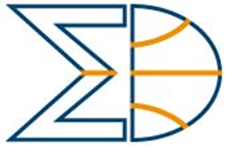
This is the Logo of WFNMC. It was used originally as logo
of the Federation Conference in Pravets, Bulgaria, in 1994.
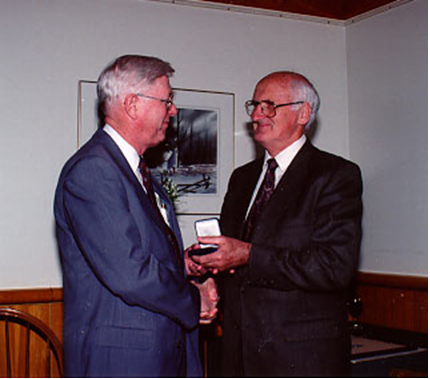
Ron Dunkley (left) receives his Paul Erdös Award from Peter O'Halloran (Canada, 1994)
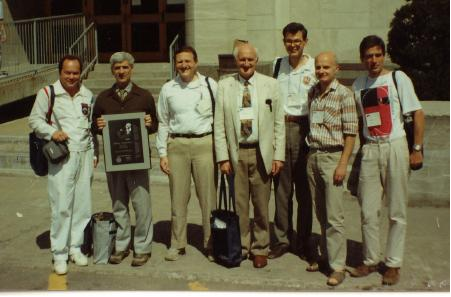
Nikolay Konstantinov with colleagues after receiving his Paul Erdös Award at ICME-7, Quebec, in 1992. From left: Alexander Soifer (USA), Nikolay Konstantinov (Russia), Mark Saul (USA), Peter O'Halloran (Australia, WFNMC President), Ed Barbeau (Canada), Marcin Kuczma (Poland) and Kiril Bankov (Bulgaria).
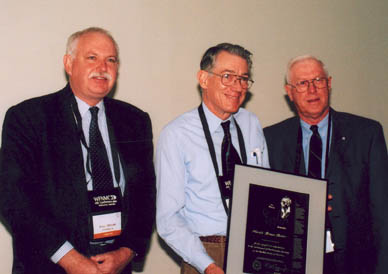
Harold Reiter (centre) receives his Paul Erdös Award from WFNMC President Peter Taylor (left) and WFNMC Awards Committee Chairman Ron Dunkley (right). The presentation took place on Saturday 10 August 2002, at the Ibis Hotel, Melbourne, as part of WFNMC's 4th conference.
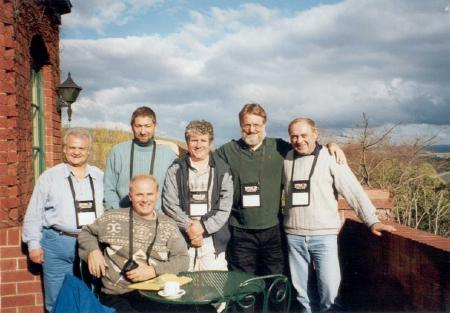
(Rear) Slavy Bilchev (Bulgaria), Vasile Berinde (Romania), Josef Molnar (Czech Republic), John Conway (USA), Jaroslav Svrcek (Czech Republic). (Front) Jaroslav Zhouf (Czech Republic).
Melbourne Conference, 2002.
Melbourne Conference, 2002.
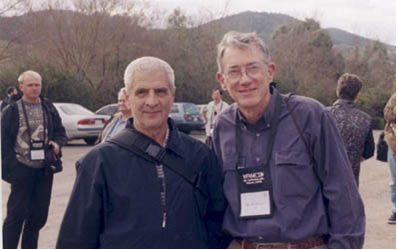
Nikolay Konstantinov (Russia) with Harold Reiter (USA).
Melbourne Conference, 2002.
Melbourne Conference, 2002.
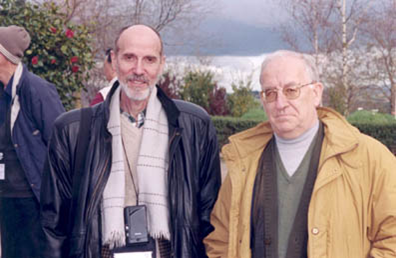
Jordan Tabov (Bulgaria) with Francisco Bellot-Rosado (Spain).
Melbourne Conference, 2002.
Melbourne Conference, 2002.
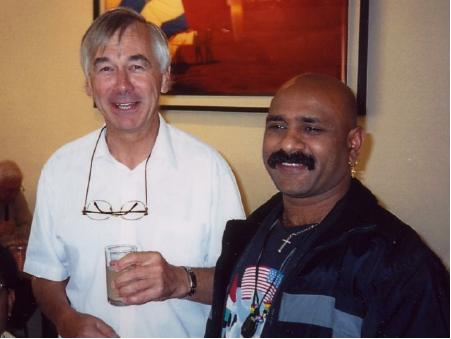
Tony Gardiner (England) with Alan Nambiar (South Africa).
Melbourne Conference, 2002.
Melbourne Conference, 2002.
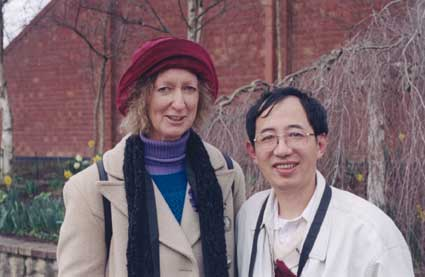
Lois Taylor (Australia) with Wen-Hsien Sun (Taiwan).
Melbourne Conference, 2002.
Melbourne Conference, 2002.
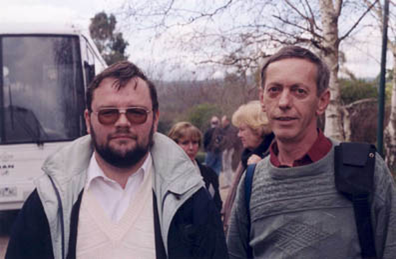
Matjaz Zeljko (Slovenia) with Aleksander Potocnik (Slovenia).
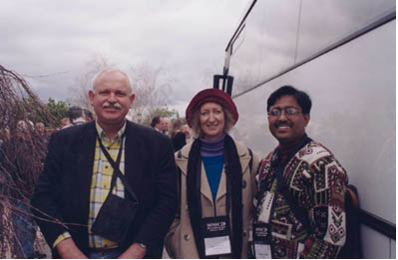
Peter and Lois Taylor (Australia) with Prodipta Hore (India).
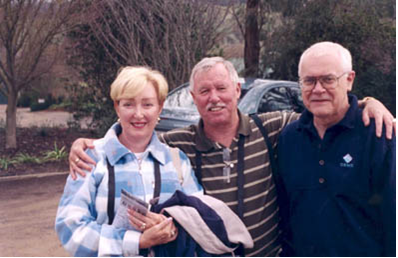
Patricia and Gareth Griffith (Canada) with Andre Ladouceur (Canada).
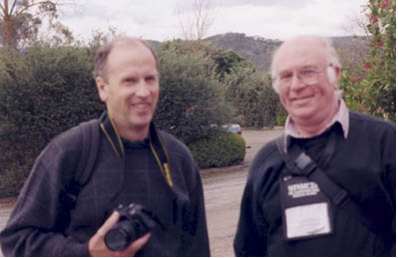
Howard Groves (Wales) with Bill Richardson (Scotland).
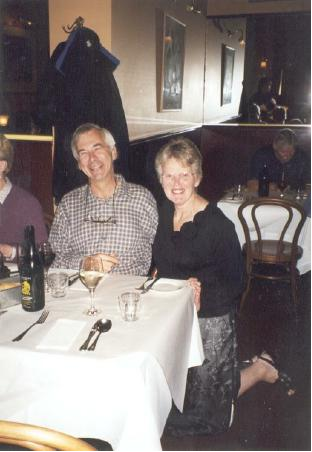
Tony and Gwyn Gardiner (England).
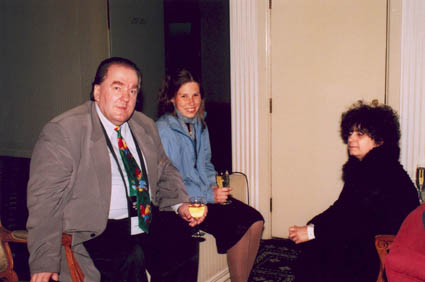
Agnis Andjans (Latvia), Liga Ramana (Latvia) and Emilia Velikova (Bulgaria).
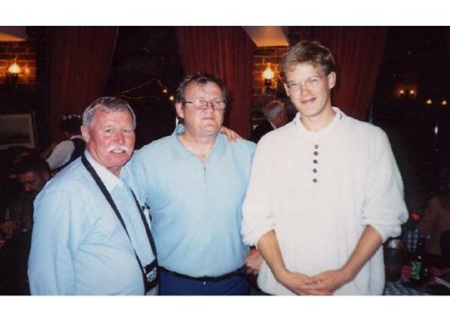
Gareth Griffith, Peter Crippin, and Ian Vanderburgh, all from Canada.
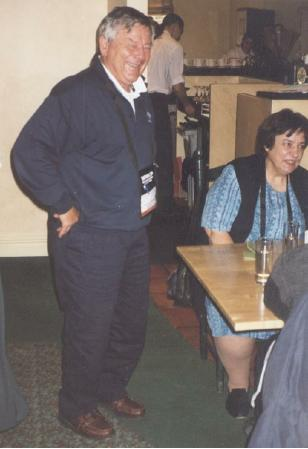
Warren Atkins (Australia) with Fernanda Cannon (Australia)
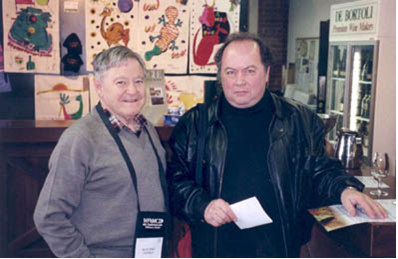
Geoff Ball (Australia) with Alexander Soifer (USA)
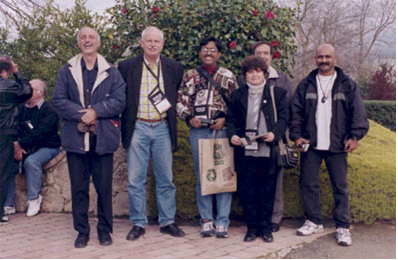
From left: Hossein Pourkazemi (Iran), Peter Taylor (Australia), Prodipta Hore (India), Emilia Velikova (Bulgaria), Ali Rejali (Iran), Alan Nambiar (South Africa).
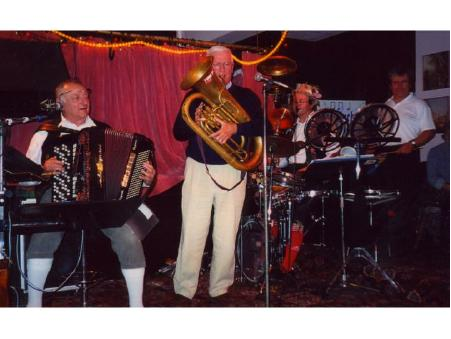
Ron Dunkley (Canada) at the Cuckoo.
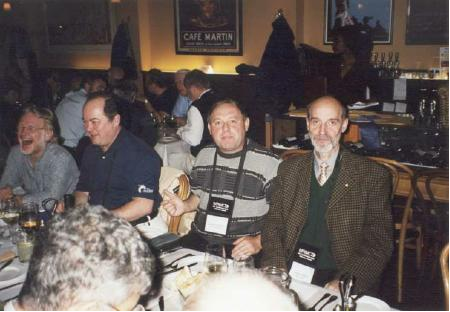
Maurice Starck (New Caledonia), Alexander Soifer (USA), Jaroslav Svrcek (Czech Republic) and Jordan Tabov (Bulgaria).
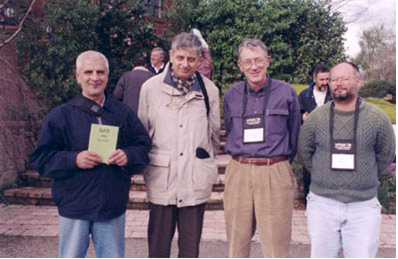
From left: Nikolay Konstantinov (Russia), Petar Kenderov {Bulgaria), Harold Reiter (USA) and Blair Kelly (USA).
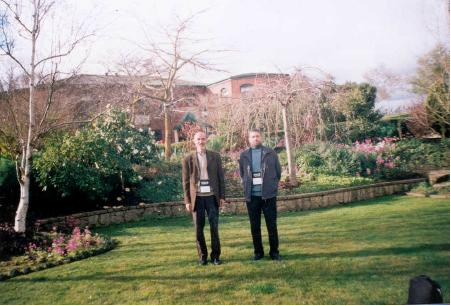
Jordan Tabov (Bulgaria) with Vasile Berinde (Romania).
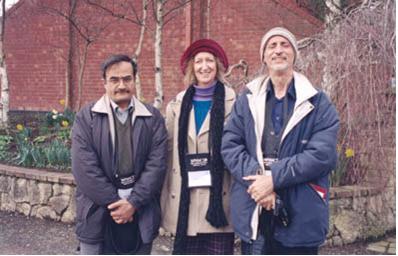
From left: Ali Rejali (Iran), Lois Taylor (Australia) and Hossein Pourkazemi (Iran).
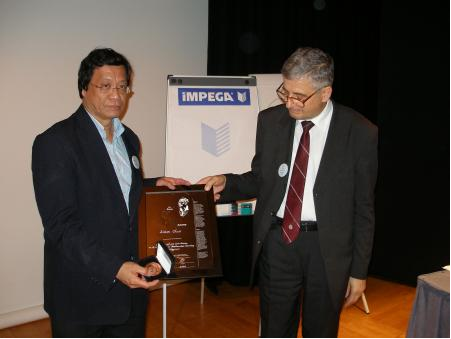
Simon Chua (Philippines) receives his Paul Erdös Award from WFNMC President Petar Kenderov, Cambridge 2004.
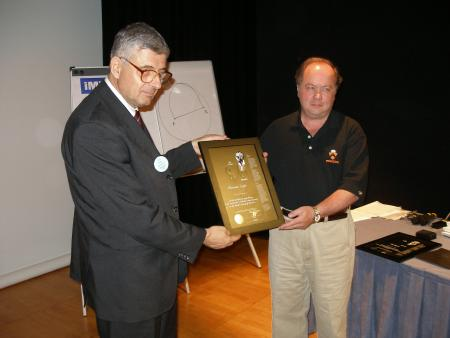
Alexander Soifer (USA) receives his Paul Erdös Award from WFNMC President Petar Kenderov, Cambridge 2004.
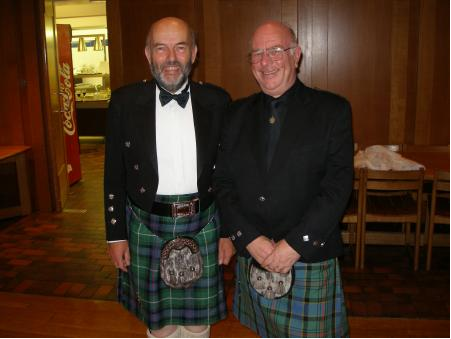
Adam McBride and Bill Richardson (Scotland), Cambridge 2004.
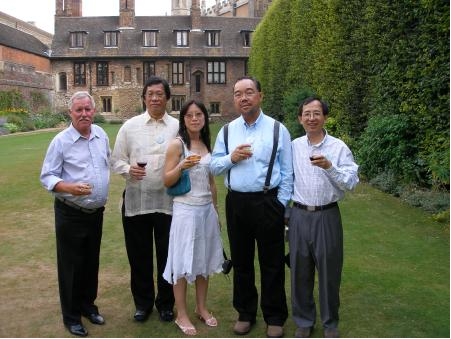
Gareth Griffith (Canada), with Simon Chua (Philippines), Fung Yee Poon (UK), Cheung Pak Hong (Hong Kong) and Sun Wen-Hsien (Taiwan) at Trinity College, Cambridge, 2004.
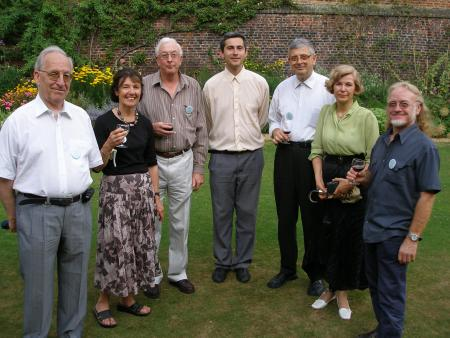
Francisco Bellot-Rosado (Spain), Helen and Bruce Henry (Australia), Ivaylo Kortezov (Bulgaria), Petar and Julia Kenderov (Bulgaria) and Maurice Starck (New Caledonia) on the lawns of Trinity College,Cambridge, 2004.
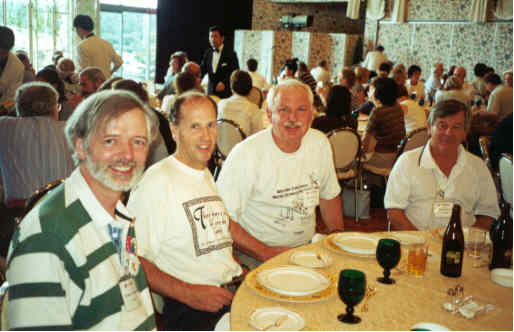
Bernard Hodgson, from Quebec and Secretary of ICMI, Howard Groves (UK Chairman of Junior Challenge Problems Committee), Peter Taylor (Australia) and Warren Atkins (Australian Mathematics Competition Problems Committee Chairman) enjoying lunch at Mt Fuji, Tokyo 2000.
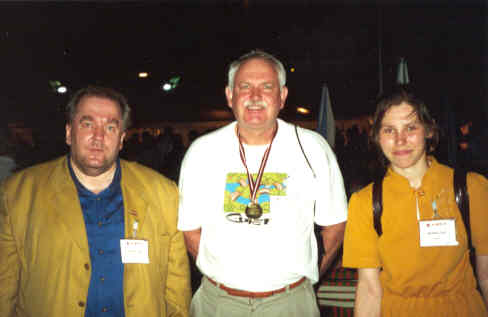
Agnis Andjans, Peter Taylor and Liga Ramana after Agnis and Liga had presented Peter's medal.
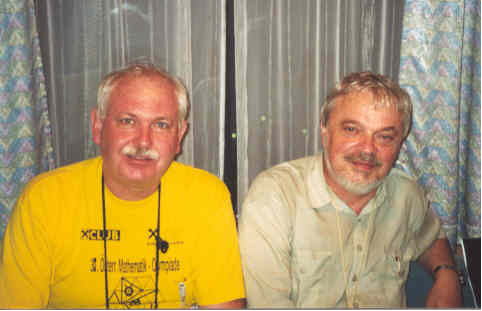
Peter Taylor (Australia) with Igor Sharygin (Russia).

Dimitar Dimitrov (Bulgaria), Kiril Bankov (Bulgaria), Alexander Soifer (USA), Ron Dunkley (Canada), Peter Taylor (Australia), Konstantine Tsiskaridze (Georgia), China, 1998.
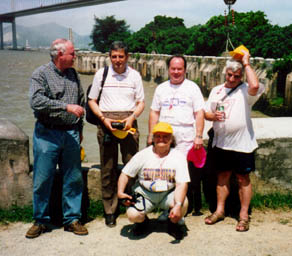
Under the giant Pearl River Estuary Bridge, Fumen, Guangdong Province, China. Standing: Peter Taylor (Australia), Petar Kenderov (Bulgaria), Alexander Soifer (USA), Nikolay Konstantinov (Russia). In front: Svetoslav Bilchev (Bulgaria), China, 1998.
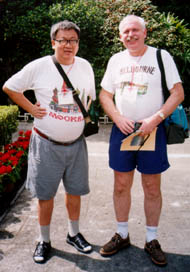
Andy Liu (Canada) with Peter Taylor (Australia), China, 1998.
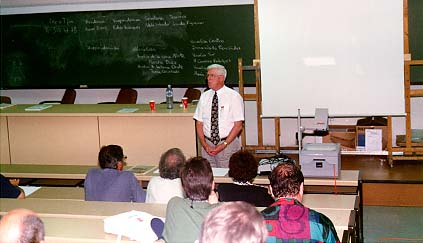
Ron Dunkley addresses the WFNMC meeting in Seville, Spain, in July 1996. Professor Dunkley was elected President of WFNMC at this meeting, where a Constitution was approved for the first time.
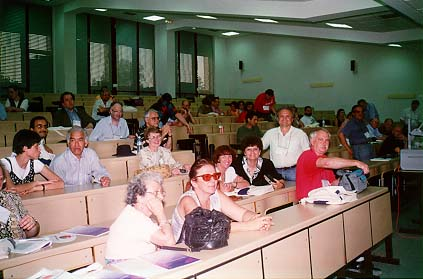
A scene at the WFNMC meeting in Seville, Spain, in July 1996.
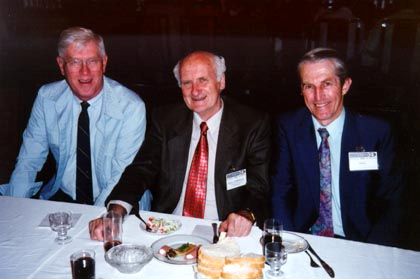
Ron Dunkley (Canada), Peter O'Halloran (Australia, President, WFNMC), John Webb (South Africa), Bulgaria, 1994.
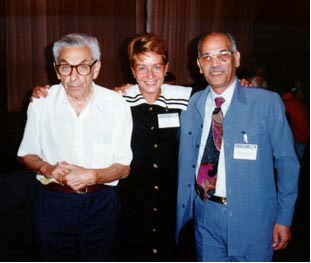
Paul Erdös with Tseni, one of the Bulgarian organisers, and William Ebeid (then of Kuwait but later Egypt), Bulgaria, 1994.
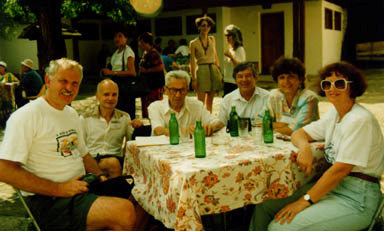
Paul Erdös with (from left) Peter Taylor (Australia), Marcin Kuczma (Poland), Warren Atkins (Australia), Emmy Velikova (Bulgaria) and Naida Atkins (Australia) during the excursion, Bulgaria, 1994.
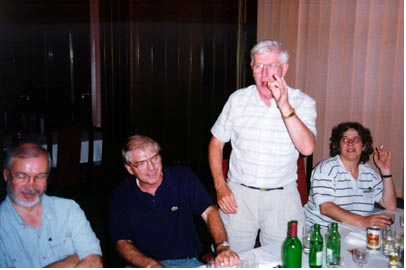
Ron Dunkley addresses the orhestra, giving his next request. Accompanied by Larry Davidson (Canada), Ron Scoins (Canada) and Patricia Fauring (Argentina), Bulgaria, 1994
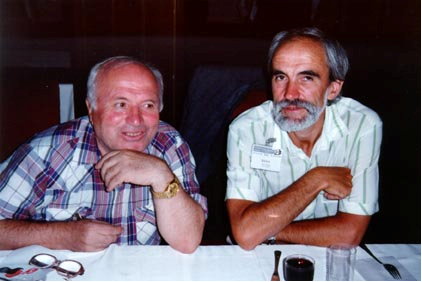
Garnik Tonojan (Armenia) and Alexei Tolpygo (Ukraine), Bulgaria, 1994.
1Berinde, V., Romania — The Native Country of International Mathematical Olympiads. A brief history of Romanian Mathematical Society. CUB PRESS 22, 2004.
2Century 2 of KöMal, ed. by Vera Oláh (editor), G.Berzsenyi, E. Fried and K. Fried (assoc. editors) OOK-PRESS, Veszprém, Hungary.
3Mathematics Competition, Vol.3 No. 2, December 1990, p. 2
4Petar S. Kenderov, Proceedings of the International Congress of Mathematicians, Madrid, Spain, 2006, p.1583 — 1598
2Century 2 of KöMal, ed. by Vera Oláh (editor), G.Berzsenyi, E. Fried and K. Fried (assoc. editors) OOK-PRESS, Veszprém, Hungary.
3Mathematics Competition, Vol.3 No. 2, December 1990, p. 2
4Petar S. Kenderov, Proceedings of the International Congress of Mathematicians, Madrid, Spain, 2006, p.1583 — 1598
